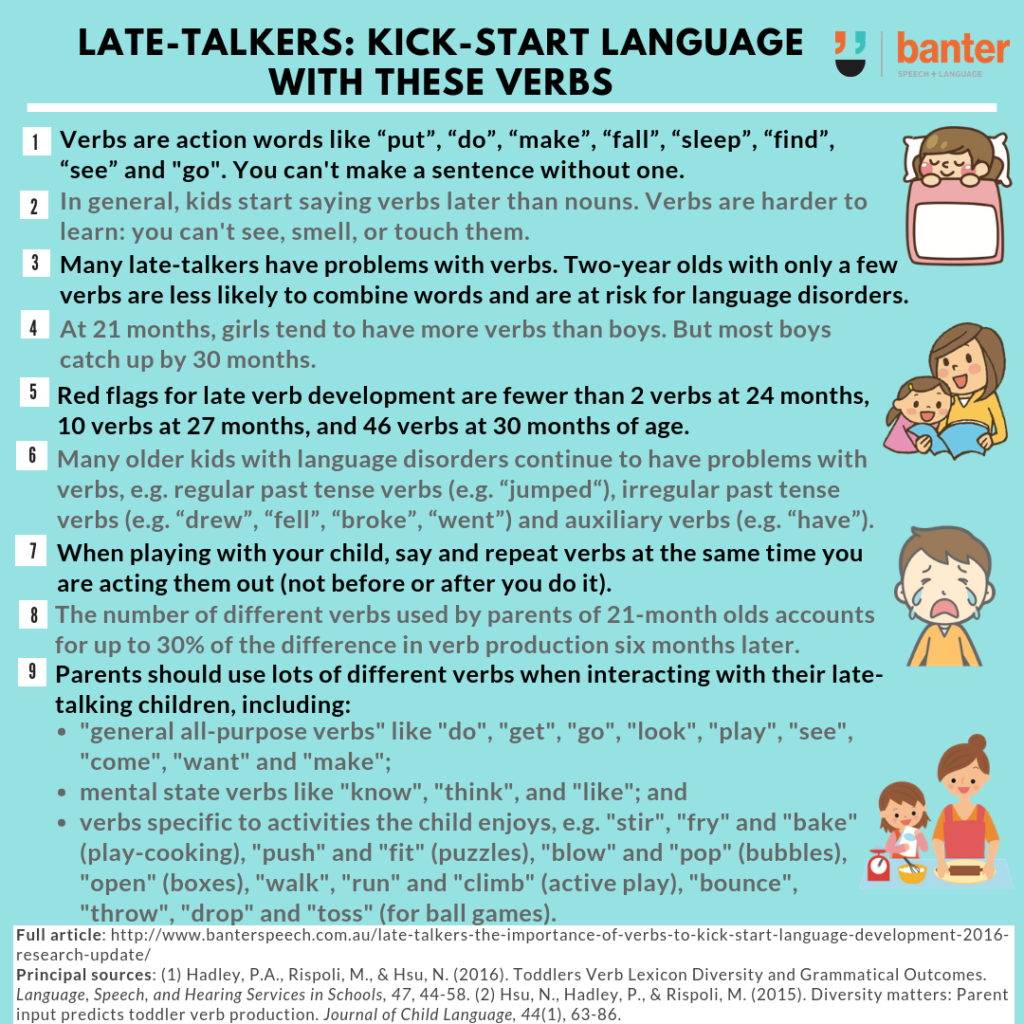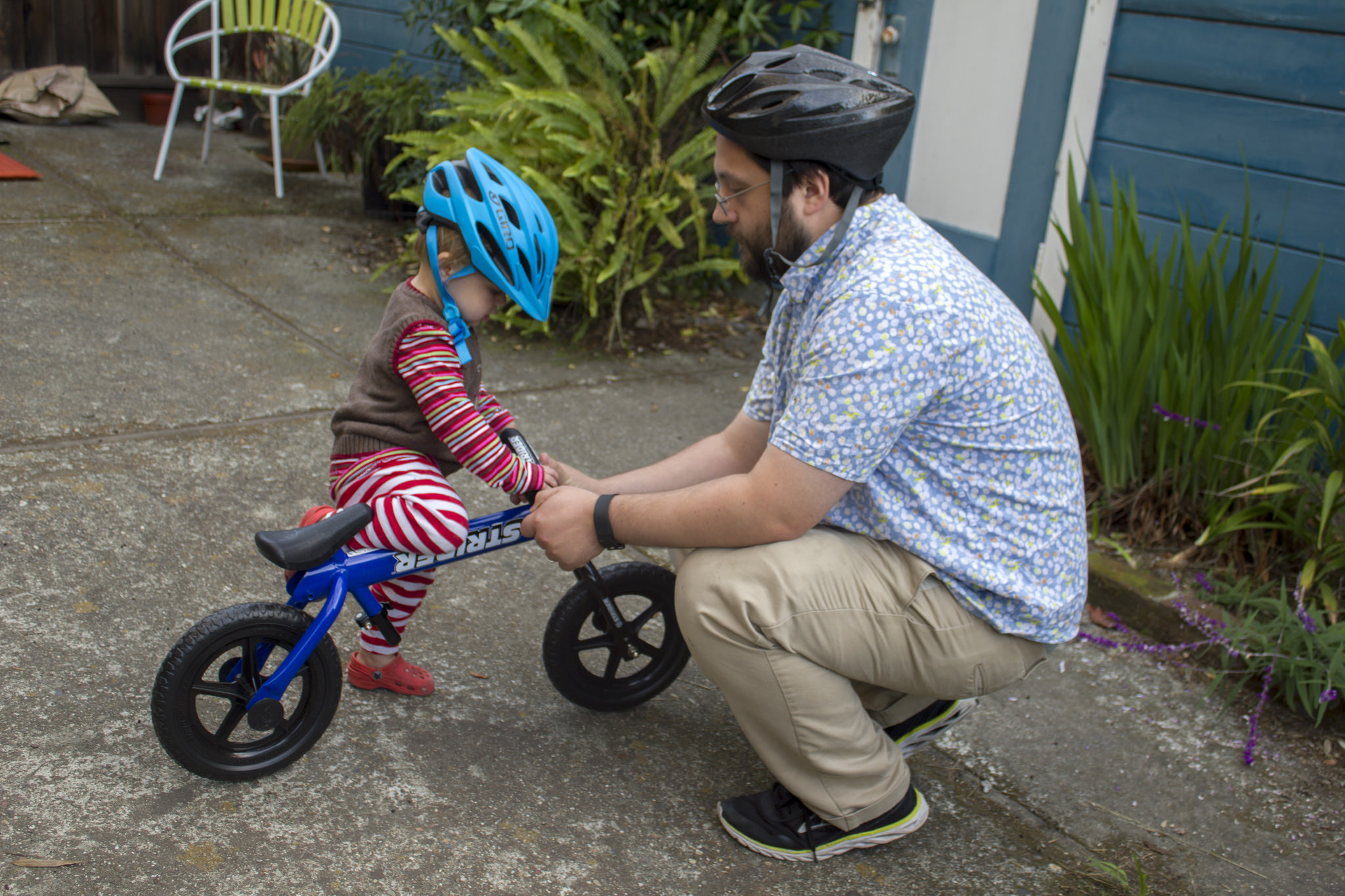Late-talkers: kick-start language with these verbs
The more research I read, the more I work with families of late-talkers, the more I find myself harping on about verbs (action words like “put”, “do”, “make”, “fall”, “sleep”, “find”, “see”, etc). This article summarises some of the latest research on verbs and late-talkers; and gives parents and others specific guidance on: (i) when they should be concerned; and (ii) the kinds of verbs to focus on at home and/or in speech-language therapy.
1. Late-talkers and verbs
We’ve talked before about the importance of verbs for late-talkers, for example, here and here.
Verbs emerge later than nouns and are harder to acquire. Early nouns refer to concrete entities (e.g. bear, Mum). But verbs are often about transient events (e.g. Gleitman et al., 2005).
Compared to children without language disorders:
- late-talking toddlers have problems learning, remembering and using verbs (e.g. Widfuhr et al., 2002);
- late-talking toddlers use dramatically fewer verbs – an average of about 3 compared with almost 46 for typically developing toddlers (Ellis Weismer et al., 2001); and
- older children with a history of language disorders have problems using verbs correctly. For example, they often struggle with regular past tense verbs (e.g. “jumped“), irregular past tense verbs (e.g. “drew”, “fell”, “broke”, “went”) and auxiliary verbs (e.g. “have”) (e.g. Leonard, 2014).
2. Why verbs matter
- Two-year olds with only a few verbs in their vocabulary are at increased risk of language disorders (Olswang et al., 1998).
- Verbs are essential for many word combinations and all sentences. A lack of verbs means late-talking two-year olds are less likely to combine words than 16-month olds with the same size vocabulary (Ellis Weismer et al., 2001).
- Knowledge and use of different kinds of verbs may kick-start grammatical development (e.g. Tomasello, 2005). Researchers talk about verbs having a “privileged” role in sentence production (e.g. Bock & Levelt, 1994).
This is why some therapy programs actively target verbs as a goal of speech-language intervention (e.g. Earle & Lowry, 2015).
3. Different verb types help children make different kinds of sentences
(a) Transitive and intransitive verbs:
- “transitive verbs” like “put” must have a direct object, e.g.: “I put the book on the table.”
- “intransitive verbs” like “sleep” don’t require a direct object, e.g.: “The baby is sleeping.”
There is some evidence that the degree of growth over a 3-month period in the average sentence length of a late-talking 31-36 month old may be related to the number of intransitive verbs the child has (e.g. fall, walk) (Olswang, 1997).
(b) Some verbs are specific to a speaker’s perspective on what’s happening. For example, consider:
- The girl sold her toy car to the boy.
- The boy bought the toy car from the girl.
These both mean the same thing, and both have the same object (the toy car). But the noun phrase is different. Thus, using different verbs (sold, bought) increases the child’s opportunity to produce differently structured sentences.
(c) Choice of verb can affect aspect and tense. For example, consider these sentences:
- Bill is watching Mum do the ironing now.
- Bill sees Mum do the ironing now.
“Watch” is more passive than “see”, and passive verbs are more likely to be marked for progressive aspect in the present tense (i.e. by adding -“ing”). We would not usually say “Bill is seeing Mum do the ironing now”. In this way the meaning of different verbs change the grammar.
4. How many verbs should my child have – when should I be concerned?
Typically developing monolingual children should have around:
- 26-29 verbs at 21 months; and
- 81-87 verbs at 30 months (Dale & Fenson, 1996, Jorgenson et al., 2010, Hadley et al., 2016).
If your child has:
- fewer than two verbs at 24 months;
- fewer than 10 verbs at 27 months; and
- fewer than 46 verbs at 30 months,
he/or she has a verb inventory smaller than that of children in the 10th percentile and may be at risk of language delay (Hadley et al., 2016). If in doubt, you may want to contact a certified practising speech pathologist for an assessment.
5. Do girls develop verbs at a different rate than boys?
Yes. At 21 months, girls tend to have more verbs than boys. But boys tend to catch up by 30 months (Hadley et al., 2016).
These findings are consistent with earlier research that shows that boys tend to have vocabulary spurts later than girls, in the third year of life. This may explain why two-year old boys flagged as late-talkers are more likely to resolve their early language delays than two-year old late-talking girls (e.g. Rice et al., 2008).
6. Can verb diversity predict later grammatical complexity?
Yes.
A child’s spontaneous production of verbs at 24 months is a good predictor of the types of sentences he or she will be able to say six months later. Specifically, the diversity of verbs used is a better predictor of grammatical outcomes than common noun diversity (Hadley et al., 2016).
7. So which verbs should parents focus on?
Recent research by Hsu and colleagues suggests that parents’ verb diversity – rather than the quantity of verbs used – is the primary factor contributing to children’s subsequent verb diversity (Hsu et al., 2015). In other words, parents should use lots of different verbs when interacting with their late-talking children, including:
(a) General all-purpose verbs
These are not tied to specific actions (e.g. Pinker, 1989) and include high frequency verbs children can use in a variety of places, including “do”, “get”, “go”, “have”, “look”, “play”, “put”, “see” and “want”. Most parents in Hsu’s studies naturally used these verbs.
(b) Mental state verbs
More than half of the parents studied by Hsu used common mental state verbs such as “know”, “think” and “like”.
(c) Verbs specific to particular activities
These verbs are commonly associated with play and other common activities. They include words like “eat”, “feed”, “cook” (when playing in the kitchen area), “fit” (for puzzles), “blow” (for bubbles), and “open” (cabinets, toys in boxes with lids).
A small minority of parents used even more specific verbs. For example:
- instead of “go” for general movement, they used verbs like “walk”, “run”, “jump” and “step”;
- instead of “play”, they used precise play action verbs like “bounce”, “lift”, and “toss”; and
- instead of “cook”, they used more specific verbs such as “stir”, “fry” and “bake”.
The Hsu et al., 2015 study showed that meaning-specific verbs, like those above, are critical for children to develop their inventory of verbs. The researchers found that the diversity of verbs used by parents of 21-month olds accounted for up to 30% of the difference in the children’s verb production six months later.

8. Clinical bottom line
With late-talkers, parents and speech pathologists should monitor the number and type of verbs a child says, and track the growth in a child’s inventory of verbs. The best way of doing this is by recording the child’s spontaneous speech.
Parents and others should try to use a range of verbs with their children, including all-purpose verbs, mental state verbs, and verbs specific to particular activities. Language therapy focused on verbs may support the acquisition of sentence structure. Increasing the number and diversity of verbs is an evidence-based speech therapy goal for late-talking toddlers.
Related articles:
- Late talkers: how I choose which words to work on first
- “My toddler doesn’t speak at all!” Don’t panic – get informed
- Why I tell parents to point at things to help late talkers to speak
- Subject-Verb Sentence Builders
- Subject-Verb-Object Sentences Builders
- The High Frequency Verb Library
- Books with verbs to level up your child’s language development: 24 of the best
- More verb-charged books to ignite your child’s language development
Principal sources:
(1) Hadley, P.A., Rispoli, M., & Hsu, N. (2016). Toddlers Verb Lexicon Diversity and Grammatical Outcomes. Language, Speech, and Hearing Services in Schools, 47, 44-58.
(2) Hsu, N., Hadley, P., & Rispoli, M. (2015). Diversity matters: Parent input predicts toddler verb production. Journal of Child Language (forthcoming), accessed online on 11 April 2016.
Image: http://tinyurl.com/zwc8tl5

Hi there, I’m David Kinnane.
Principal Speech Pathologist, Banter Speech & Language
Our talented team of certified practising speech pathologists provide unhurried, personalised and evidence-based speech pathology care to children and adults in the Inner West of Sydney and beyond, both in our clinic and via telehealth.








